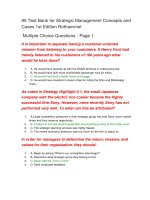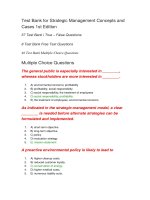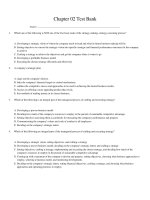Test bank business ethics concepts and cases chapter 71
Bạn đang xem bản rút gọn của tài liệu. Xem và tải ngay bản đầy đủ của tài liệu tại đây (83.5 KB, 4 trang )
1.
What are the three basic elements of discrimination in employment? Why is each
element necessary to the definition?
2.
Discrimination in employment involves three basic elements: it must be a decision not
based on individual merit, the decision must derive from racial or sexual prejudice, and
the decision must have a harmful impact on the interest of employees.
a.
True
b.
False
3.
Discriminatory acts themselves can be categorized according to the extent to which they
are intentional and institutionalized. An act may be part of the isolated behavior of a single
individual who intentionally discriminates based on personal prejudice; be part of the
routine, institutionalized behavior of a group; and which intentionally discriminates out of
personal prejudice.
a.
True
b.
False
4.
What is the distinction between institutionalized and isolated discrimination? Can
discrimination be unintentional as well as intentional?
5.
What types of comparisons can be drawn to prove that discrimination exists?
6.
An indication of discrimination exists when a disproportionate number of a certain group's
members hold less desirable positions despite their preferences and abilities.
a.
True
b.
False
7.
Types of comparisons to provide evidence of discrimination are:
a.
Comparisons of average benefits given to various groups.
b.
Comparisons of the proportion of a group found in the lowest levels of the institution.
c.
Comparisons of the proportion of a group found in the most advantageous positions in the institution.
d.
All the above
e.
B&C
8.
Can the large disparities between white males and women or minorities be accounted for
by the preferences of women and minorities? What other reasons might there be for the
disparities?
9.
Why, according to the utilitarian view, is discrimination in the workplace unethical?
10.
Arguments against discrimination are:
a.
Utilitarian, rights, and justice arguments.
b.
Rights, entitlements, and fairness arguments.
c.
Justice and Kantian arguments.
d.
Civil and criminal.
e.
All the above
11.
"It might be true that society as a whole would benefit by having some group discriminated
against" is a/an _____ argument for discrimination.
a.
Kantian
b.
Utilitarian
c.
Capitalist
d.
Communist
12.
How do rights theorists argue against discrimination? What are the justice-based
arguments against it?
13.
What kinds of employment practices are clearly discriminatory?
14.
Kant would argue that humans should be treated as ends in themselves and never as a
means to an end. Therefore, discrimination is wrong because it violates people's rights
to be treated as equals.
a.
True
b.
False
15.
Rawls would argue that it is unjust to give some people more opportunity than others.
a.
True
b.
False
16.
If sexual harassment is illegal and clearly immoral, how can the guidelines against sexual
harassment be controversial? What aspects do some find problematic?
17.
What are the two types of arguments used to justify affirmative action? What are the
strengths and weaknesses of both attempts?
18.
Widely recognized categories of discriminatory practices include:
a.
Recruitment practices that rely on the word-of-mouth referrals of present employees will tend to
recruit only from the groups already represented.
b.
Screening practices that include qualifications not relevant to a job.
c.
Promotion practices that place groups on separate tracks or that rely solely on seniority when past
discrimination has kept women or minorities out of senior positions.
d.
All the above
e.
A&B
19.
Affirmative action programs call for positive steps designed to eliminate the effects of past
discrimination. Such programs are now legally required of all firms holding government
contracts.
a.
True
b.
False
20.
Does preferential treatment violate the principle of equality? Why or why not?
21.
What are comparable worth programs? How are they justified? What objections do
critics raise against them?
22.
Since the jobs women have historically taken pay low wages and salaries, proponents of __
__________programs attempt not to place women into higher paying jobs, but to increase
the salaries of those jobs where women currently are employed.
a.
Competitive Value
b.
Competitive Position
c.
Comparable Worth
d.
Comparable Equity
23.
Misiolek made only sex-based insults, not both sex and race-based insults.
a.
True
b.
False
24.
An argument (s) against affirmative action plans is that criteria besides sex and race must
be weighed when making job decision because. Which of the following are used?
a.
Unqualified workers will be hired and productivity will go down.
b.
Jobs that have a significant impact on the life or health or the entire success of the company.
c.
It will turn us into a more racially and sexually conscious nation.
d.
A&C
e.
All of the above
25.
In a class action law suit, Wal-Mart was charged by seven women that women were paid 5-1
5% less than men in holding similar positions.
a.
True
b.
False
26.
The needs of minorities are not different from those of women.
a.
True
b.
False
Test Name: chapter 7
1.
2.
3.
4.
5.
6.
7.
8.
9.
10.
11.
12.
13.
14.
15.
16.
17.
18.
19.
20.
21.
22.
23.
24.
25.
26.
a.True
a.True
a.True
d.All the above
a.Utilitarian, rights, and justice arguments.
b.Utilitarian
a.True
a.True
d.All the above
a.True
c.Comparable Worth
b.False
e.All of the above
a.True
b.False









